This manual covers hardware connection, software installation and settings of Cropster’s Roasting Intelligence for PT-100/PT-1000 type RTD sensors connected via a VINT Hub Phidget and TMP1200.
This roast machine is currently in the Beta stage of development at Cropster.
To access this integration, please register for Beta testing by completing the provided form here.
Beta testing involves the evaluation of new features by a limited group of users to uncover potential minor issues that may not be apparent during internal testing.
Your feedback is crucial in helping us improve the functionality of our product. Please let us know in case you come across any unexpected behavior.
We will be happy to assist in resolving any issues you may encounter or propose alternative connection options.
Legal Note
Please read this installation and configuration guide carefully, as any mishandling could lead to permanent device damage.
By connecting a Phidget device or temperature probe to any computer or by installing Cropster’s Roasting Intelligence (RI) software, the user agrees to release Cropster from any liability and assumes any possible risk related to the use of this measuring device and/or software. Cropster's terms of service apply.
Cropster cannot advise on the installation of the hardware, and to ensure safety when installing any hardware on your machine, Cropster recommends consulting with a technician who can help with the installation.
Specifications
Requirements
-
RTD Phidgets (TMP 1200): supports 2-, 3-, 4-wire RTD mode
The TMP 1200 only allows one RTD sensor per device. You need one TMP1200 per RTD sensor. -
Phidgets cables (e.g. 3002_0, 3003_0, 3004_0 )
There are various types of Phidgets cables available for the connection. Please consult the Phidgets website for the TMP1200, and click on Connection & Compatibility to learn more about whether the Phidgets cable you use is supported by the Phidgets device.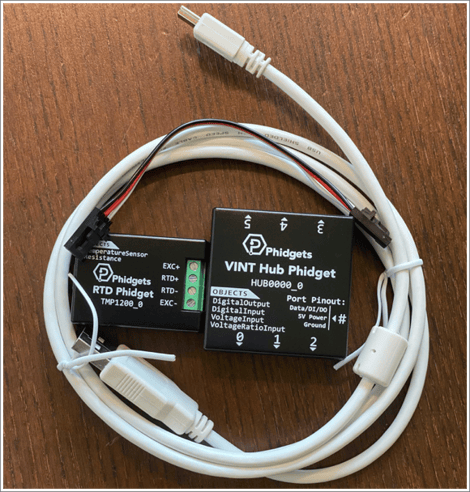
Setup options
You cannot splice the probe cables to use for parallel readouts (e.g., digital readout on roasting machine and input for Roasting Intelligence data bridge will not work).
Depending on your setup and the type of probes, there are two connection options:
Direct connection
A direct connection applies when adding new probes independently from the roaster's readout. The newly added probe can be connected directly to the Cropster Connector.
Dual connection
A dual connection applies when the roaster is equipped with a dual probe. A dual probe is a probe with two sensors inside the hull and two pairs of wires that allow a simultaneous connection to Cropster and the roaster's readout.
VINT Hub + TMP1200 installation
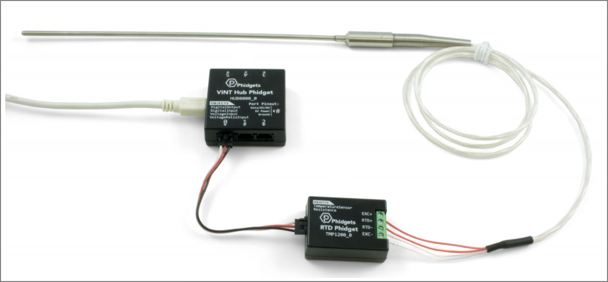
VINT Hub HUB0000 (now HUB0001_0) on the left, connected to a TMP1200 on the right, using a Phidgets cable to perform the connection between the two devices. A 4-wire mode RTD temperature sensor, is connected into the TMP1200.
Disconnect the USB cable from the VINT Hub and turn off your roast machine during the hardware installation.
- Follow the probe cable from the tip of the probe to its end where the wires appear.
In case of dual probes, take the free end that is not connected to the roaster. - Confirm the number of wires available for your PT-100/PT-1000 RTD probe, and follow the next step accordingly:
Two-wire:
To connect a 2-wire RTD to the RTD Phidget, connect one wire to the RTD+ terminal, and the other to the RTD- terminal. Then connect the EXC+ terminal to the RTD+ terminal and the EXC- to the RTD- terminal with two short wires.
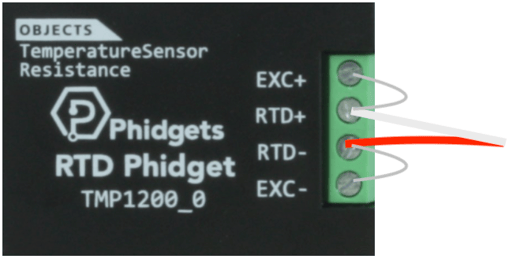
This is the simplest wiring setup for an RTD, but also the least accurate because the resistance of the leads are not taken into account.Three-wire:
Your RTD should have two wires that share a color; connect one of these wires to the RTD- terminal and the other to the EXC- terminal. The differently colored wire connects to the RTD+ terminal. Then connect the EXC+ terminal to the RTD+ terminal with a short wire.
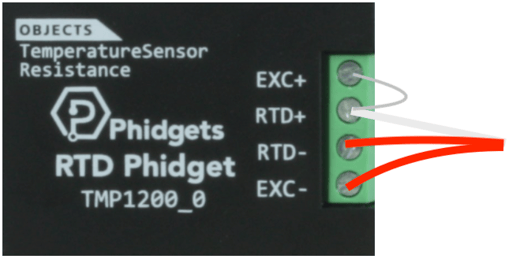
In a three-wire RTD, the extra wire is added to measure the resistance of one of the leads. This calculation assumes that both leads have the same resistance.
Four-wire:
To connect a four-wire RTD, simply connect one pair of same-colored wires to the RTD+ and EXC+ terminals, and the other pair to the RTD- and EXC- terminals.
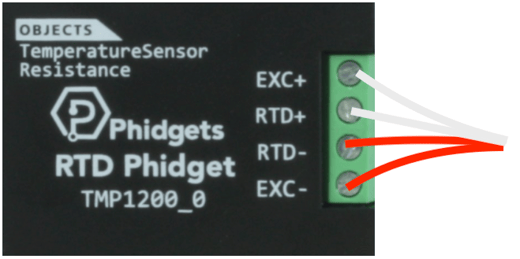
A four-wire RTD is normally used in precision measurement, when the assumption that both leads have the same resistance is not accurate enough. Unfortunately, the RTD Phidget does not support this particular feature of four-wire RTDs. It does support the use of four-wire RTDs using the same assumption as three-wire mode. - Connect the TMP1200 to the VINT Hub using your Phidgets cable.
- Repeat the installation steps for each RTD sensor you wish to connect to a TMP1200.
- Connect the VINT Hub to your computer with the provided USB cable and proceed with the software setup.
Roasting Intelligence (RI) Setup
Installing the Roasting Intelligence (RI) software
-
Download RI.
- Download the Phidget driver.
-
Complete the installation process by following the steps provided.
- Double-click the Cropster icon on your desktop to access RI.
- Click the green Login with the browser button.
💡 Select the "Remember me on this device" option to save your login credentials for future access.
- You will be directed to the C-sar browser.

- Enter your Username* and Password* and click the green Sign in with password button.
💡You need to use the same credentials that you use to access the online platform C-sar.
Check out the Release notes for every version of RI5 to stay updated on the latest features and improvements. You can access the Release notes directly in RI by clicking on Help > Release Notes.
Establishing a connection to the machine
The images displayed below are meant to serve as reference examples; however, they may differ slightly from what you will see on your screen.
Before you begin configuring your roast machine, ensure that you have added it via the online platform, C-sar.
- Click
 Preferences > Machine > Configuration, bottom left, to access the Preferences screen.
Preferences > Machine > Configuration, bottom left, to access the Preferences screen. -
To choose the Roast machine, click on the dropdown menu in the Machine section.
-
By clicking on the + Add connector option, you can choose your connector from the available options in the dropdown list.
- You need to select the Phidgets RTD Sensor (TMP1200) from the dropdown.

- Click Select to add the connector.
-
Navigate to the Machine > Measurements tab. All supported measurements will be displayed.
-
To activate the measurements, simply click the green toggle button.
-
Switch on the measurements you would like to enable and select the Phidgets RTD Sensor (TMP1200 from the dropdown.
💡 Make your measurement readouts more compact. Choose the size of your measurement readouts by selecting either the Small or Large view for display. -
Change the order of the measurements by using the
-png.png?width=16&height=16&name=DragAndDropIcon%20(1)-png.png) Drag and Drop icon and move it into position.
Drag and Drop icon and move it into position.
- Navigate back to the Machine > Configuration tab and click on the
 Gear icon in the Connector setup section next to the previously added connector to open and configure more settings.
Gear icon in the Connector setup section next to the previously added connector to open and configure more settings. - Select the Hub port.
💡The Hub port refers to the port on the VINT Hub. If the TMP1200 is connected to VINT Hub's port 0, select 0 under Hub port. - Select the Type of RTD temperature sensors.
💡Please check the manufacturer's probe specifications to identify the type. e.g., An RTD with 100 ohm resistance, and a 3850 ppm/k, corresponds to the PT100_3850 option.
- PT100 or PT1000 = Platinum sensor with 100 or 1000 ohm resistance
- 3850 or 3920 ppm/K = temperature coefficient
- Navigate back to the Machine > Configuration tab and click on the
 Gear icon in the Connector setup section next to the previously added connector to open and configure more settings.
Gear icon in the Connector setup section next to the previously added connector to open and configure more settings. - Click on the Wiring mode dropdown menu, and select the wiring mode corresponding to the number of leads/wires coming from your PT100/PT1000 probe.
-
Select Phidgets RTD Sensor (TMP1200) from the drop-down for all measurements connected to the VINT Hub's ports, via a TMP1200.
- Wireless VINT Hub (i.e., HUB5000) ONLY:
- Enter the hostname/IP address and port.
- Hostname/IP address:
The hostname or IP address of your Wireless VINT Hub - Port: The port of the Phidget Server configured on your Wireless VINT Hub.
- Hostname/IP address:
- Enter the hostname/IP address and port.
- Click OK.
- Click Save to finalize the changes.
- After saving the changes, RI will automatically restart. If the setup was successful, you will see the temperature values displayed on the right-hand side of the RI screen following the restart.

📚 Learn more about the Roasting Intelligence (RI) Preferences.
Troubleshooting
If the RI indicates No source connected and/or you cannot see any measurements, please check the following:
- Is the TMP1200 connected to the VINT Hub?
- Is the VINT Hub connected to the computer?
- Is the Phidgets driver installed?
- Mac only: Has the Phidgets driver been enabled in the Mac's Security & Privacy settings?
If the temperature deviates a few degrees:
- Try the different options for your type of RTD sensor under the Type drop-down menu.
Congratulations! You have successfully set up the Cropster Roasting Intelligence!
Check out the Roasting Intelligence (RI5) - Getting Started manual and enjoy tracking your first roasts! More manuals and videos can be found on help.cropster.com.
